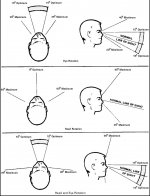Mark,
Sounds like our birding styles are similar, even down to thinking that singing birds are lower than they really are. I also agree with you that super wide angle binoculars are not particularly useful for birding. I'm just not willing to deal with the unpleasant aberrations and distortions that come with 80 degree fields, even with Nagler eyepieces (really especially with the huge pincushion distortion of Nagler eyepieces). From long experience with many binoculars I know that I'm happy enough once the AFOV reaches about 60 degrees and I don't pine for anything over about 65-70 degrees.
Henry
Hi Henry,
I concur with your conclusions, and also the earlier admonition about the apparent field being the correct reference for "wideness." I would also note that there is an inevitable tendency to mix birding with astronomy applications, which are vastly different in requirements.
For birding binoculars my thinking is based more on human engineering analysis than optical engineering. To me it's axiomatic that the best visual instrument should be the most compatible with the way the human body works, and not force behaviors that are uncomfortable or unnatural.
This now famous 1976 diagram hasn't changed over many revisions of MIL-STD-1472 concerning Human Engineering Design Criteria. I don't know the underlying research that led to it, but it has been widely accepted for equipment design throughout the world. Of course, to be relevant here it has to be interpreted in a viewing situation using binoculars.
Here is now the authors describe the way eye-head movements work. I'll just quote it:
Discussion. Focal vision is the central 30° of the visual field, pictured as the shaded area in the top panel of the Exhibit 5.1.2.10, (along with the range of eye movements with the head stationary). This is the area that people use to look at objects in the world, moving their eyes as needed to bring images of the object on to the fovea, which is the area of highest acuity. When an object is outside of the focal area, a person will usually turn the head rather than simply move the eyes. The range of head rotation is illustrated in the second panel of Exhibit 5.1.2.10. The combined range of combined head and eye movement is illustrated in the third panel of Exhibit 5.1.2.10. By locating frequently used displays in the central 30° of visual field, the user is not required to move his or her head to bring the information into the focal area, presumably minimizing neck strain.
Now an important point about binoculars. With unaided vision the angular movement of the head and eyes trade off 1:1. One can either move the eyes x degrees to the left or right, or the head. The net result is that the image of an object can be centered on the fovea either way, or by a combination of head and eye movements so long as they sum to x degrees.
Using binoculars the situation is modified. Head motion still associates with object location, but eye movement associates with
magnified retinal location. In other words, the image of a real object x degrees to the left or right can still be centered by head motion of x degrees, but it takes eye motion of M*x degrees to center the object's image using only the eyes. A consequence of magnification, therefore, is that the eye becomes (so to speak) M times less efficient for centering the images of real objects than the head.
The diagram shows that using eye rotation alone, optimum lateral movement is ±15º, with a maximum of ±35º. The ±15 degree region, I'm sure, corresponds to a zone of "reasonable" acuity. The outer region corresponds to a retinal projection area, or apparent field of view, of up to 70º —which by happy coincidence coincides with quality binoculars that are usually 60º — 70º.
It's obviously not a hard limit, but if the field edge is beyond a ±35º, eye muscles become progressively more fatigued, and for me that's unreasonable. It is also true, although unmentioned in this discussion, that eye rotation mechanically results in ray clipping at the point where the exit pupil meets the eye pupil, — about 3mm behind the cornea. The observer is also called upon to recenter the instrument, although this doesn't alleviate the clipping problem.
It could still be argued, of course, that there is an advantage in presenting a larger magnified field to: (a) increase the psychological sense of "presence," or (b) provide peripheral cues for guiding search movements. That may (or may not) be true, but such an increase in field comes at the expense of eye relief, which in my opinion is much more important. About 75% of the US population uses either spectacles or contact lenses. in addition, as recently discussed on other threads, both presence and peripheral cues are somewhat compensated for when glasses are used, because unmagnified peripheral images become available to the eye. Although opinions may differ about the value of this, my experience is that conventional eyecups invariably create tunnel vision, independent of the apparent field.
Anyway, that's how I see it.
Ed





